|
Bonica/JVC HM-650
Bonica supplies a full, high quality and reasonably priced HD video system in a handy travel bag
(by Conrad H. Blickenstorfer; photography by Carol Cotton)
Shooting decent video underwater used to be a complex and costly endeavor available to just a few. The cameras were big and bulky and a complete underwater rig cost a fortune. 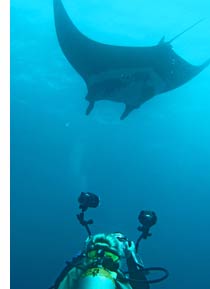 Then compact digital cameras got movie modes and all of a sudden divers could shoot video clips. For several years these were low resolution and often pixelated, but then new compression technology and high capacity storage media made high definition video possible in ever smaller packages. Then compact digital cameras got movie modes and all of a sudden divers could shoot video clips. For several years these were low resolution and often pixelated, but then new compression technology and high capacity storage media made high definition video possible in ever smaller packages.
That's where Bonica comes in. Bonica, a company that's been concentrating on underwater imaging since 1985, is in the market of finding and creating good, inexpensive components for underwater video and then selling the packages with everything you need for a very fair price. In this review we're describing our experiences with one of Bonica's higher end packages that includes a JVC HM-650 HD video camera, an underwater housing, two powerful lights with arms and mounting brackets, all the necessary adapters, and a nice travel bag.
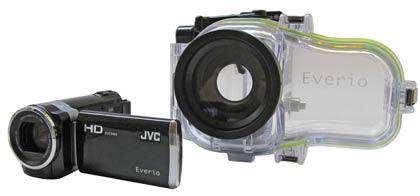
When shooting pictures or video underwater, a good marine case is as important as the camera itself, and those cases can be quite expensive as well as bulky and heavy. Depending on design, features and implementation, an underwater case can cost several times as much as the camera itself. With their JVC-based systems, Bonica aims to offer a reasonable balance between a good camera, a good case, and good lights. And then they make available whatever else you need to end up with the best possible underwater HD video.
The picture below shows the complete Bonica/JVC system:
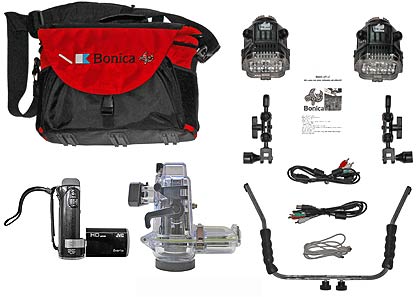
And here is what it all looks like in action on a dive at Socorro:
 Bonica JVC HM650 with dual G8V15 video lights
Bonica JVC HM650 with dual G8V15 video lights
The JVC HM650 camera itself
There have been great advances in video camera technology over the past few years. When we reviewed one of Bonica's lower-end underwater video packages not too long ago, we marveled how an inexpensive little camera could shoot very good 720P video at a blistering 60 frames per second. Bonica still sells those "Snapper"-based systems that can now do full 1080P video, but the HM650 camera in this review is a good step up from the Snapper.
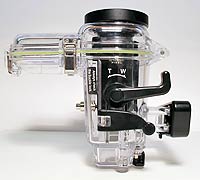 The HM650 is made by JVC, which offers a large variety of ultra-compact consumer video cameras that use either internal hard disks or Flash memory. The JVC in our review package was a GZ-HM650, a very compact handheld capable of recording full 1080p high definition video either onto its 8GB internal memory or onto SD/SDHC/SDHX cards. The camera can also shoot 3-megapixel still pictures, and you get a 40X optical zoom. There's a built-in LED illuminator for a bit of extra light in dark settings. The camera has an "intelligent auto recording" mode that selects from 12 preset scenes, almost full manual mode, and a variety of cool tricks. The HM650 is made by JVC, which offers a large variety of ultra-compact consumer video cameras that use either internal hard disks or Flash memory. The JVC in our review package was a GZ-HM650, a very compact handheld capable of recording full 1080p high definition video either onto its 8GB internal memory or onto SD/SDHC/SDHX cards. The camera can also shoot 3-megapixel still pictures, and you get a 40X optical zoom. There's a built-in LED illuminator for a bit of extra light in dark settings. The camera has an "intelligent auto recording" mode that selects from 12 preset scenes, almost full manual mode, and a variety of cool tricks.
This camera is a small, modern vidcam with a bright fold-out 2.7-inch wide-format display that also rotates 270 degrees, a straightforward touch interface, digital image stabilization, and time lapse recording, all in a light and handy black high-gloss body that weighs just eight ounces, battery included. Above water, the touch screen can be used to focus on whatever you touch and the camera will expose that area properly. If you study the detailed manual deeper, you find cool stuff like an auto recording feature that detects movement, advanced face detection technology with face registration and even smile recognition, easy uploading to YouTube, and so on.
Underwater case system
The Bonica/JVC system comes with an underwater case designed especially for this camera. It is the JVC WR-MG300 Marine Case, a clamshell design made of clear polycarbonate that can handle depths to 130 feet, which so happens to be the recommended depth limit for recreational scuba diving. The housing uses three strong metal clasps and a greenish-yellow O-ring to keep water out. Unlike the Bonica "Snapper" systems that have an electronic remote control inside the housing to access most system functions, the JVC housing only lets you access the basics: power, zoom, taking stills and recording video.
The underwater case accommodates the camera's fold-out LCD by being form-fitted around it. And the case leaves enough room around the video display to let you rotate it about 30 degrees for a viewing angle that feels comfortable to you when diving. Good thinking. Below you can see the camera in the housing from the front:
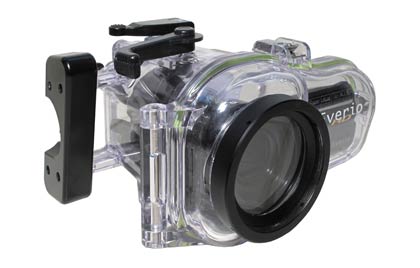
Note the large zoom and snapshot controls on top of the housing. They make operation very easy, and the very large labels next to them help remember what these controls do.
Below is the whole assembly from the rear. You can get a good view of the LCD so you can see what you're recording. The black button to the right of the battery case starts and stops video. The black handle on the right side is one of the weaker parts of the case. It's hard and not very ergonomically shaped. On the other hand, the case is large enough to accommodate an extended life battery, which is a good thing as the standard battery only lasts an hour of recording or so. We recommend the optional higher capacity battery.
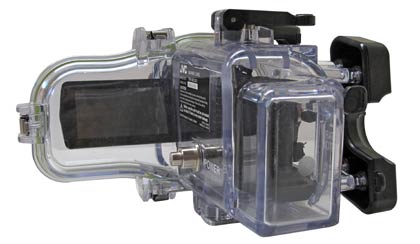
Enough light is always important when shooting video. Underwater it is absolutely crucial. Fortunately, the G8V15 lights that come with the Bonica/JVC package are up to the job. They are attractive and very solid aluminum/polycarbonate designs with six LEDs each. 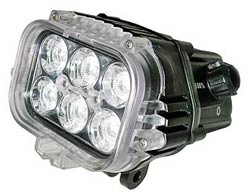 These lights, which are rated to a maximum depth of 180 feet, can crank out 1,500 Lumen and burn for a full hour at maximum intensity on a charge. Within their 60 degree coverage angle there is no hotspot, which means everything is evenly lit. Each light has two controls. One knob either turns on full power or sets it to adjustable power. A second knob lets you set intensity from 10 to 100%. Color temperature is 6500 degrees, which approximates daylight. Each light takes eight AA NiMH rechargeables, so make sure you bring along enough chargers. These lights, which are rated to a maximum depth of 180 feet, can crank out 1,500 Lumen and burn for a full hour at maximum intensity on a charge. Within their 60 degree coverage angle there is no hotspot, which means everything is evenly lit. Each light has two controls. One knob either turns on full power or sets it to adjustable power. A second knob lets you set intensity from 10 to 100%. Color temperature is 6500 degrees, which approximates daylight. Each light takes eight AA NiMH rechargeables, so make sure you bring along enough chargers.
Below you can see the Bonica/JVC camera system with the lights in use during a dive.
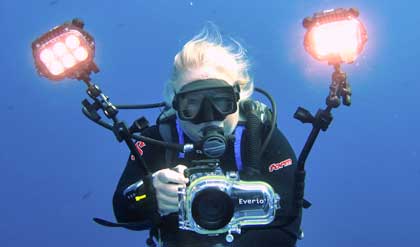
The full Bonica/JVC setup with dual video lights
Things to consider when getting ready
Getting a full underwater camcorder setup ready for use is more involved than just putting the camera into its case. Before you do anything else, make sure you know how to operate the camera and that it is set properly. That means spending quality time with the manual. Do not skip that step! For example, it's easy to overlook that the camera can take still pictures while you are recording video. Or that while there is no underwater scene mode, there are two manual underwater white balance settings.
The HM650 camera boots up into automatic mode, so there isn't much to set unless you want to shoot in a particular manual mode, which is not really recommended since you cannot manipulate the touch screen menus once the camera is in its case. Also, make sure you know whether you want to record on internal memory or onto an SD card; you don't want to run out of space during a dive (yes, it happened to us)!
The marine housing has a special camera mounting shoe to secure it inside the housing. Make sure it's properly seated. Also make certain that the somewhat undersized standard battery is fully charged before a dive.
Another thing to consider is fogging. Shooting video underwater means the camera and housing will be subjected to very different temperatures and a lot of moisture and humidity. The JVC Marine Case manual suggests using both anti-fog liquid and a drying agent. That's important. There's nothing worse than filming the dive of your life just to find out later that your lens was fogged up! We always used two or three 3-gram desiccant packages to make sure the lens wouild not fog up.
Setting up the video lights requires some assembly also, especially when you travel and need to disassemble your gear. The main bracket consists of two parts so that the Bonica setup can be operated with either one or two lights. That requires a Philips screwdriver, so make sure you have one handy at the dive location. 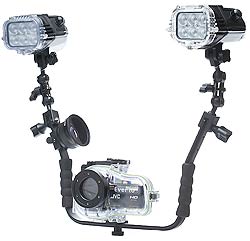 The bracket arms are made of aluminum and are very light compared to some of the gear we've tested. Ball joints allow them to be twisted and rotated at any angle and in any direction. The balls are hard plastic with grooves for rubber rings that provide the necessary friction. The attachment fixture on the lights is sturdy enough and the clamp has a metal insert. The ball joint extension is pretty much needed so you can adjust your lights as required. The bracket arms are made of aluminum and are very light compared to some of the gear we've tested. Ball joints allow them to be twisted and rotated at any angle and in any direction. The balls are hard plastic with grooves for rubber rings that provide the necessary friction. The attachment fixture on the lights is sturdy enough and the clamp has a metal insert. The ball joint extension is pretty much needed so you can adjust your lights as required.
A video system that includes two lights adds to your travel bulk, but the full JVC/Bonica setup is still fairly light and everything fits into the bag that comes with the package. On land the small size and light weight of the JVC vidcam means you can take it almost anywhere. Under water the camera in its housing is positively buoyant. This means it won't ever drop to the bottom, but it also means you need to make sure it doesn't escape to the surface and you may need an extra pound or two of weight on your weightbelt or weight-integrated BC. However, if you use it with the two video lights, the overall system becomes negatively buoyant.
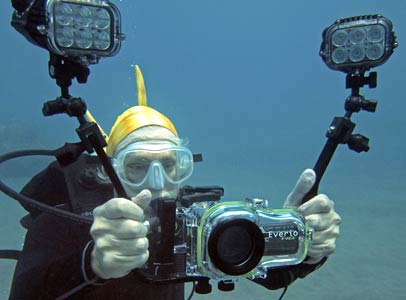
The full Bonica/JVC video/still camera system with dual lights
Going underwater
Camera controls on the Bonica/JVC setup are as simple as can be. They are also large enough to be operated even with thick gloves on. There is a big lever for the zoom (which we don't recommend using much; it's hard to hold a camera under water still enough for good video). Behind it is a very large shutter for taking stills. A smaller button at the back starts and stops video recording. Buttons are clearly marked in large white text and they are easily reachable. The one big problem with the controls is that you cannot access camera settings other than turning the camera on and off.
Shooting video is very straight-forward. Taking stills is much easier than with the JVC HM550 Bonica used in its JVC packages before; with that camera you had to remember to stop recording video before you could take a still shot. With the HM650 you can take a picture anytime.
Overall, we did about three dozen full dives with the Bonica/JVC on a liveaboard trip to the Mexican Archipelago Revillagigedos, also known as the Socorro islands, in Cancun, off Isla Mujeres with whale sharks, and in the Pacific off San Diego and the Coronado islands. We used it both with and without the video lights. The camera is compact enough to handle well and letting you get close to a subject more easily than with bulkier underwater camcorders. Do make sure that the camera display is tilted upward (or whatever angle works best for you) as the vertical viewing angle of the LCD is fairly narrow and you need to look at it head-on for the best picture.
We did encounter a couple of problems. A couple of times the lens fogged up because we had failed to use the recommended anti-fog and moisture-muncher. They are not always necessary, but under certain conditions (large temperature and humidity changes, for example), they are essential. And one time we ran out of storage during a dive and couldn't switch to the alternate storage because you can't access those functions with the camera inside the housing.
Balancing the system
Anytime you go underwater with a camera it's different from doing a dive without it, and that's especially the case when your rig has two big lights. You quickly find out that proper balance and buoyancy is important for comfortable use and handling. With the two video lights the Bonica/JVC setup is quite top-heavy and wants to tip over forward, making it difficult to handle the camera. Adjust the balljoint arms so that the center of gravity of the lights is exactly above the handles for easier handling underwater. It's also possible to configure the lights so that the overall center of gravity is closer to the camera, which improves handling. An inherent problem is that the lights were negatively buoyant and wants down, whereas the camera housing is positivly buoyant and wants up.
How did it come out?
What expectations should you have for a HD video system like the Bonica/JVC? In theory, 1920 x 1080 video is as good as it currently gets. It's the same resolution used for 1080p HD video on televion where you feel you're actually at the ballgame and can see every tiny little detail. Good 1080p HD video looks better than most older theater movies, and now it's all available in cameras that fit into the palm of your hand, or in this case, a compact handy underwater housing.
The answer is, as almost always, "it depends." It depends on how much light you have on a dive, what the visibilty is, whether you're holding the camera reasonably steady, and whether you've learned how the camera works best. At its best, the Bonica/JVC produced stunningly clear and beautiful video and also excellent quality stills. The camera's focusing system worked very well, and sharpness was hardly ever an issue. All the pictures in the image bars on the right were shot with the Bonica/JVC (except the ones where the camera is in it, of course).
It'd be nice to see the camera boot up faster from a cold start. I missed a few opportunities because I turned the camera off to conserve battery, then the camera booted up slowly while my subjects swam away.
It would also be nice to have some sort of dark shield over the screen. Underwater the LCD screen was often very hard to see. I am also wondering if there's a way to make the part of the housing directly in front of the screen to where it magnifies.
Compared to Bonica's lower end Snapper systems that use an Aiptek camera, the JVC HM650 is better able to handle reflections, contrasts and high dynamic range situations. The JVC also does quite well in low light, but having adequate light is always better underwater. While this means better overall video quality, our recommendation remains the same:
In order to get the best possible video (and stills) from this very reasonably priced system, observe these rules.
- Always use as much natural or strobe light as possible. This is the only way to get good color in an underwater environment.
- If you have a choice, do your video recording on bright, sunny days so you get as much ambient light underwater as possible.
- Use the proper (optional) filters; they can compensate a bit for the colors lost at depth.
- Move around as little as possible. The best video results from holding the camera totally still and have the scenery move instead.
- Plan on spending several hours reading and comprehending the manual. There is an awful lot to this JVC camera that is not immediately obvious, or it is buried deep in menus.
How about still shots? Here you need to consider that the HM650 has a rather small 1/4.1" CMOS imager with just 3.3 megapixel. That's plenty enough for 1080p video which uses just 1,920 x 1,080 pixels, but it means the maximum still picture size is 2,400 x 1,344 pixel, or about 3.3 megapixel. And stills taken while recording are just 2 megapixel (1,920 x 1,080). So this is not the camera to make large prints from. The good news is that the stills are actually quite good. But you do need to be aware that they can be no larger than 3.3 megapixel.
How the HM650 differs from earlier Bonica/JVC cameras
Bonica always tries to stay up to date in the cameras they offer, and that isn't always easy as the cameras must fit the underwater cases, cases must be available, brackets and lights must fit, and so on. In this instance, the GZ-HM650 was part of a January 2011 announcement by JVC. The new models now used touch screens for operation and offered stunning 40X optical zoom. But this year's HM650 isn't simply a newer, higher end version of the HM550 Bonica used in its JVC package in 2010. In some ways, the HM550 was a higher end system that included GPS, Bluetooth, a larger 1/2.3-inch 9.3 megapixel imager, it had a flash and it came with 32GB of internal storage.
The new HM650 is smaller and weighs less, has a better user interface, the big 40x zoom, but no GPS, Bluetooth or flash, and it only has 8GB of internal storage. JVC actually offers the HM670 and HM690 with 32 and 64GB of internal storage, respectively, but those cameras cost significantly more. With the HM650, users can decide what size SD card they want to invest in. So you win some and you lose some. In our book, the new, handier camera is a very good choice. Things do add up pricewise, though. The two lights with mounting hardware add US$850 to the basic US$1,499 camera package, and with compacts and dSLRs shooting increasingly good video, the decision between a package that's primarily video and one that's primarily stills is becoming more difficult.
Summary
With their latest JVC-based package, Bonica offers a modular underwater high-definition video camera system that can record full 1920 x 1080 pixel video for excellent 1080p playback on a HDTV, shoot 3-megapixel still pictures, and capture 2-megapixel stills while filming. The package strikes a good balance between a feature-rich, versatile and handy HD video camera, a very well made underwater housing good for 130 foot dives, and powerful LED lights with very even coverage. The setup is very easy to use and produces excellent HD video as well as good (albeit only 3mp) still shots from its CMOS imager. 8GB of internal flash storage fills up quickly, but the SD card slot means you can add up to 64GB of recording capacity. Highly recommended.
Bonica/JVC HD video underwater system
We like:
- Very good and sharp 1080p (1920 x 1080 pixel) HD video
- Excellent, well-made underwater case for dives to 130 feet
- Very simple operation
- 40X optical zoom and digital image stabilization
- You can shoot video and still pictures at the same time
- Can shoot amazingly good still pictures
- Has 8GB internal Flash and a SDHC/SDHX card slot
- Extensive manual modes and numerous features
- Camera small and handy; still handy even inside case
- Powerful LED video lights
- Much improved touch screen interface
- High quality case, lights, filters and accessories
Not so much:
- Menu functions not accessible when camera is in case
- 8GB internal storage small (make HM670/690 available?)
- LCD has narrow vertical viewing angle
- Standard battery too small
- Stills only 3 megapixel max
- We encountered fogging issues
|










